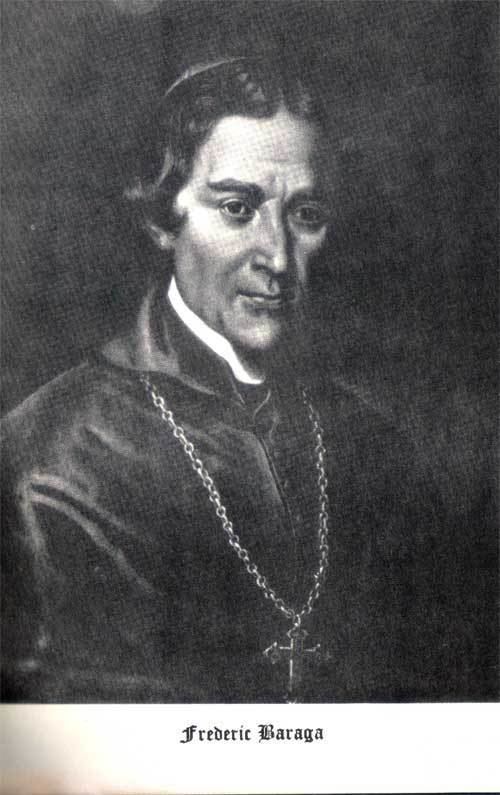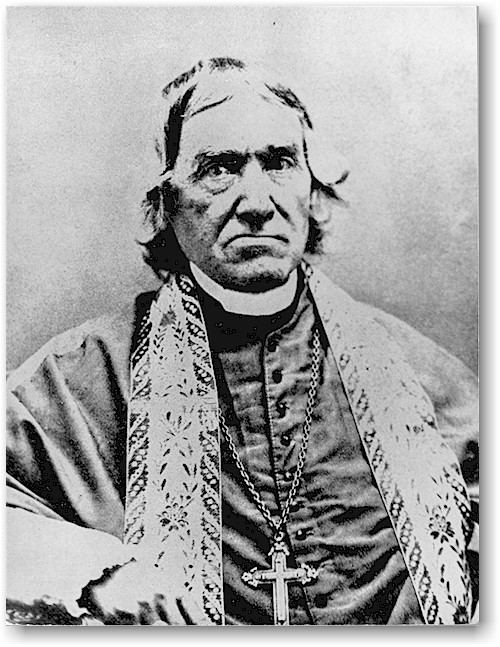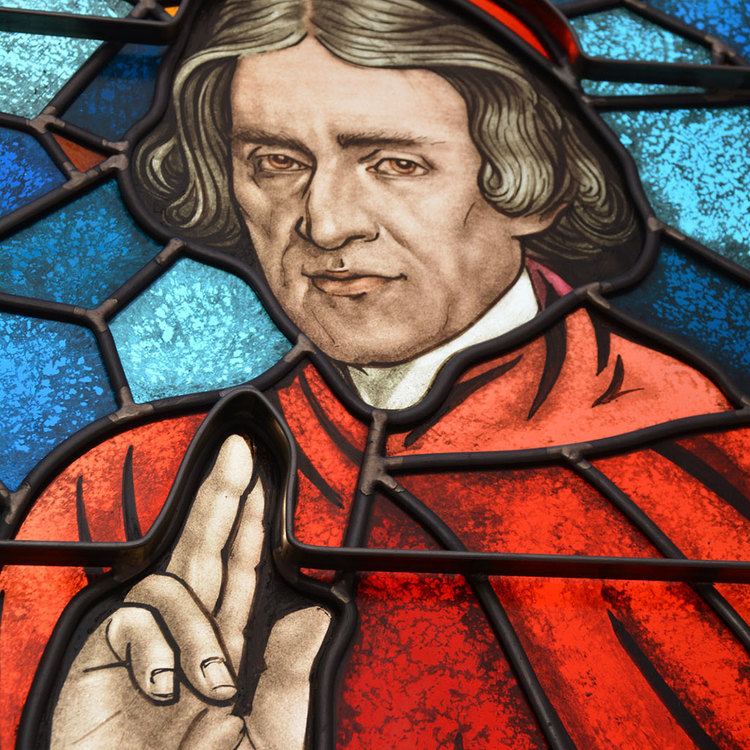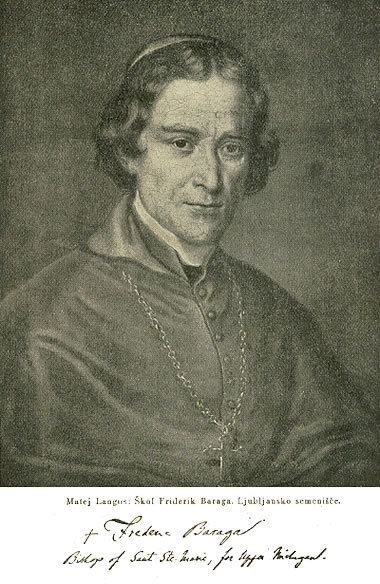Name Frederic Baraga Role Missionary | Appointed January 9, 1857 Term ended January 19, 1868 | |
 | ||
Ordination September 21, 1823by Augustin Johann Joseph Gruber Parents Maria Katharine Josefa, Johann Nepomuc Baraga Books A Dictionary of the Oji, A dictionary of the Otc, The diary of Bishop Frederic, A Theoretical and Pract, Frederic Baraga's Short hist | ||
Bishop frederic baraga s tomb and shrine
Irenaeus Frederic Baraga (June 29, 1797 – January 19, 1868; Slovene: Irenej Friderik Baraga) was a Slovenian Roman Catholic missionary to the United States and a grammarian of Native American languages. He became the first bishop of the Roman Catholic Diocese of Marquette, Michigan, originally sited at Sault Sainte Marie, which he led for 15 years.
Contents
- Bishop frederic baraga s tomb and shrine
- Bishop frederic baraga sculpture dedication 2012 piazza secchia at cathedral square
- Early life
- Priesthood
- Bishop
- Legacy and veneration
- References

His letters about his missionary work were published widely in Europe, inspiring Saint John Neumann and Father Francis Xavier Pierz to emigrate to the United States. He has been honored as 'Venerable.'

Bishop frederic baraga sculpture dedication 2012 piazza secchia at cathedral square
Early life

Frederic Baraga was born in the manor house at Mala Vas (German: Kleindorf) no. 16 near the Carniolan village of Dobrnič, in what was then Lower Carniola, a province of the Duchy of Carniola in the Habsburg Monarchy. Today it is a part of the municipality of Trebnje in Slovenia. Never using his first name, he was baptized Irenaeus Frederic.

He was the fourth of five children born to John Nepomuc and Maria Katherine Josefa de Jencic Baraga. His mother inherited upon her father's death the estate of Mala Vas, plus a substantial fortune. His mother died in 1808, and his father in 1812. Frederic spent his boyhood in the house of Dr. George Dolinar, a lay professor at the diocesan seminary at Ljubljana.
Baraga grew up during the Napoleonic Wars, when France had taken over the Slovene Lands from the Austrian Empire for a time. As a result, the official language of instruction in his schools changed several times during his childhood between Slovenian and German. By the time he was nine, he was fluent in French as well. In addition, Latin and Greek were required subjects for all students. Thus, by age 16, Frederic Baraga was multilingual—a skill that would serve him well in later life.
Priesthood

Baraga attended law school at the University of Vienna, where he graduated in 1821. Influenced by Clement Mary Hofbauer, Baraga then entered the seminary in Ljubljana. At age 26, he was ordained a Roman Catholic priest on September 21, 1823 in the Cathedral of St. Nicholas by Augustin Johann Joseph Gruber, the Bishop of Ljubljana. As a young priest, he was assigned as an assistant first at St. Martin's near Kranj and later at Metlika in lower Carniola. Father Baraga was a staunch opponent of Jansenism. During this time, he wrote a spiritual book in Slovene entitled Dušna Paša (Spiritual Sustenance).
In 1830 Baraga answered the request of Bishop Edward Fenwick of Cincinnati for priests to aid in ministering to his growing flock, which included a large mission territory. He left his homeland on October 29, 1830 and arrived in New York on December 31. He arrived in Cincinnati, Ohio on January 18, 1831. During the winter and spring he worked among the German immigrants in the area. At the same time he studied the Ottawa language, a branch of the Algonquian languages. In May 1831 was sent to the Ottawa Indian mission at Arbre Croche (present-day Cross Village, Michigan) to finish his mastery of the language.
In 1837, he published Otawa Anamie-Misinaigan, the first book written in the Ottawa language, which included a Catholic catechism and prayer book. After a brief stay at a mission in present-day Grand Rapids, Michigan, in 1835 Baraga moved north to minister to the Ojibway (Chippewa) Indians at La Pointe, Wisconsin, at a former Jesuit mission on Lake Superior.
In 1843 Baraga founded a mission at L'Anse, Michigan. During this time he earned the nickname “the Snowshoe Priest” because he would travel hundreds of miles each year on snowshoes during the harsh winters. He worked to protect the Indians from being forced to relocate, as well as publishing a dictionary and grammar of the Ojibway language. Although these works have important historical value, they are not recommended as basic resources for the language today.
Through the texts Baraga published in his missionary years, the Slovenes learned about aspects of Native American culture and the United States.
Bishop
Baraga was elevated to bishop by Pope Pius IX and consecrated November 1, 1853, in Cincinnati at Saint Peter in Chains Cathedral by Archbishop John Purcell. He was the first bishop of the Roman Catholic Diocese of Sault Sainte Marie, Michigan, now the Diocese of Marquette.
On July 27, 1852 he began to keep a diary, written in several languages (primarily German, but with English, French, Slovene, Chippewa, Latin, and Italian interspersed), preserving accounts of his missionary travels and his relationship with his sister Amalia. During this time, the area experienced a population explosion, as European immigrants were attracted to work in the copper and iron mines developed near Houghton, Ontonagon, and Marquette. This presented a challenge because he had few priests, and had to attend to the needs of immigrant miners and the Native Americans. Increased development and population encouraged the improvement of transportation on Lake Superior.
The only way to travel in winter was on snowshoes, which Baraga continued to do into his sixties. He was particularly challenged by the wide diversity of peoples in the region, which included the native inhabitants, ethnic French-Canadian settlers, and the new German and Irish immigrant miners. Difficulties in recruiting staff arose because of many languages; while Baraga spoke eight languages fluently, he had trouble recruiting priests who could do the same.
Baraga traveled twice to Europe to raise money for his diocese. On one trip he was presented a jeweled cross and episcopal ring by the Emperor Franz Joseph I of Austria. The bishop later sold these for his missions.
Baraga wrote numerous letters to the Society for the Propagation of the Faith describing his missionary activities. The Society published them widely as examples of its missions in North America, and they were instrumental in inspiring both Saint John Neumann and Father Francis Xavier Pierz to come to the United States to work. In time, Baraga became renowned throughout Europe for his work. In his last ten years, his health gradually declined; he became intermittently deaf and suffered a series of strokes. In 1865 Baraga wrote to Pope Pius IX in support of the canonization of his former confessor, Clement Hofbauer. He died January 19, 1868 in Marquette, Michigan. He is buried there in the crypt beneath Cathedral of Saint Peter.
Legacy and veneration
Baraga was declared venerable by Pope Benedict XVI on May 10, 2012. His cause was opened in 1952 by Thomas Lawrence Noa, the diocese's eighth bishop, and the formal canonization process began in 1973. The diocese planned to relocate his remains to a more accessible new chapel for veneration in the upper portion of the cathedral. At the time of his veneration, the Vatican was investigating a possible miracle for beatification.
